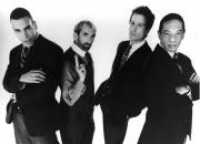Who would of thought that four actor friends, getting together in the back of a Toronto delicatessen to sing in late 1978, would be the beginning of one of the most enduring and important groups in the contemporary a cappella field? The four friends were Paul Cooper, Marc Connors, Claude Morrison and Dennis Simpson. By April 1979 the group graduated form singing for fun to the beginning of their professional career, but Dennis Simpson had gotten a gig in a musical and left the group. Ralph Cole, also a veteran of musical theater, became the bass singer. The interviews of the time provide this self-description of their music as a blend, "25 per cent Rayon (Marc Connors), 25 per cent Darvon (Ralph Cole), 25 per cent Fabulon (Claude Morrison) and 25 per cent Come on."
The rest of 1979 saw the group singing in clubs with great success and rave reviews. For example they had an unheard of 17 week run at a club called Basin Street. In the fall they made their debut on television which stimulated the formality of choosing a name. Marc and Paul came up with the Nylons in memory of the synthetic groups of the past such as the Orlons and the Chiffons. The group continued with increasing success, yet Ralph Cole retired and was replaced by Arnold Robinson who had sung and arranged for the Platters. This was the winning combination. They signed a deal with Attic Records and hit the big time with their first album which went gold in Canada in just two months! Big radio play hits from that one were "Up The Ladder To The Roof" and "The Lion Sleeps Tonight." Their second album, One Size Fits All, was distributed in the U.S. and became the foundation for their increasing fan base in this country.
In the overall history of a cappella it is important to remember just what was going on when they gained international attention. Not much. The Persuasions had an audience. Sweet Honey was growing but not yet recognized across the country beyond folk or civil rights groups. The Bobs were just beginning. The King's Singers had devoted fans, usually limited to the classical world. Ladysmith Black Mambazo was big in Africa, but effectively unknown here. Of course there were choirs and choral groups of significant local interest, some gospel and bluegrass activity, but it wasn't extensively appreciated. Therefore you can see that when the Nylons presented a cappella music and blew people away, in fact they were beginning something new. They have to be considered one of the main influences of the contemporary vocal bands.
In seven years the Nylons recorded six albums for Attic Records, constantly toured and were renown for their fabulous live shows. Marc Connors was the driving force behind the tight choreography, dramatic stage sets and quick costume changes which allowed the Nylons to be fabulous showmen. One serendipitous event was the origin of one of their performance trademarks. At the Ontario Palace in Toronto one night, the sound system failed during a show before 15,000 fans. They immediately began singing an unamplified "One Fine Day" to a crowd who became dead silent in order to hear, and then exploded into thunderous applause at the end of the song. If you're lucky you will catch them recreating that moment when you're in the audience of one of their shows. It's wonderful!
By 1990, Paul Cooper, who had been the most prolific writer and arranger in the group, retired. He was just plain exhausted from being on the road for ten years. His replacement was Micah Barnes. Then a big blow fell on the group. Marc Connors died in 1991. It would have been a devastating blow for many, but less than a month later, The Nylons were back on stage with R&B singer, Billy Newton-Davis. Not only did they have two new members, but they had a new Record Label, Scotti Brothers in Los Angeles. During their first recording, Live To Love, they tried some more instrumental accompaniment and rap/funk/R&B to appeal to a younger audience.
The quartet soldiered on until Micah Barnes and Billy Newton-Davis wished to return to solo careers. Claude and Arnold searched and found Garth Mosbaugh who had both musical theater and TV experience, and Gavin Hope who had been a member of an a cappella group which had opened for The Nylons in the past. The new foursome returned to the studio to record, and went back toward the sound which had made them so popular, vocal with some percussion.
As the a cappella world has flourished in the 1990', in no small part because of the love of the music that the Nylons created, their career has once again become as strong as ever. In 1997 Gavin Hope left to pursue solo efforts and go on stage and they found a great replacement in Mark Cassius who had been one of Toronto's foremost musical theater performers. After twenty years the Nylons aren't just an oldies but goodies act, their performances are as dynamic as ever and their new music is better than ever.
